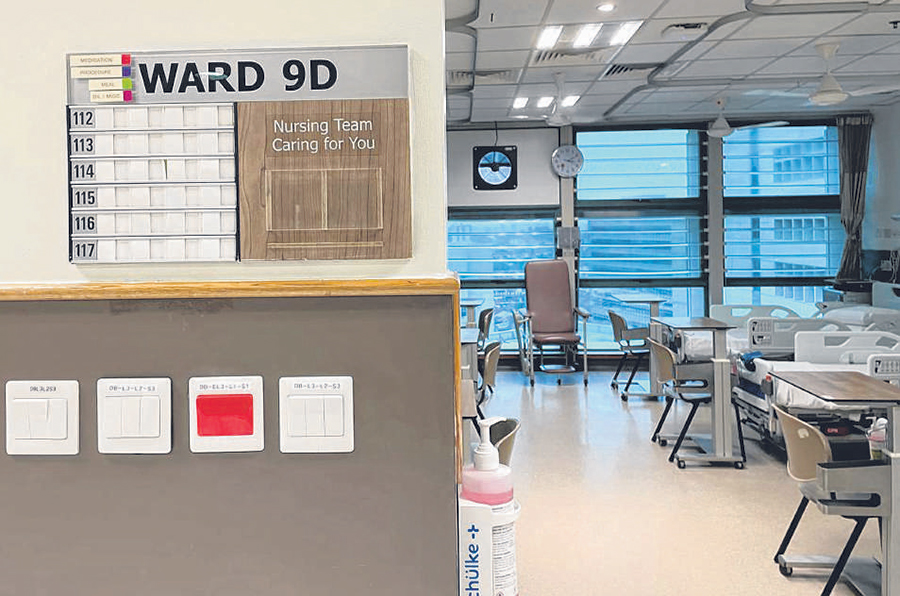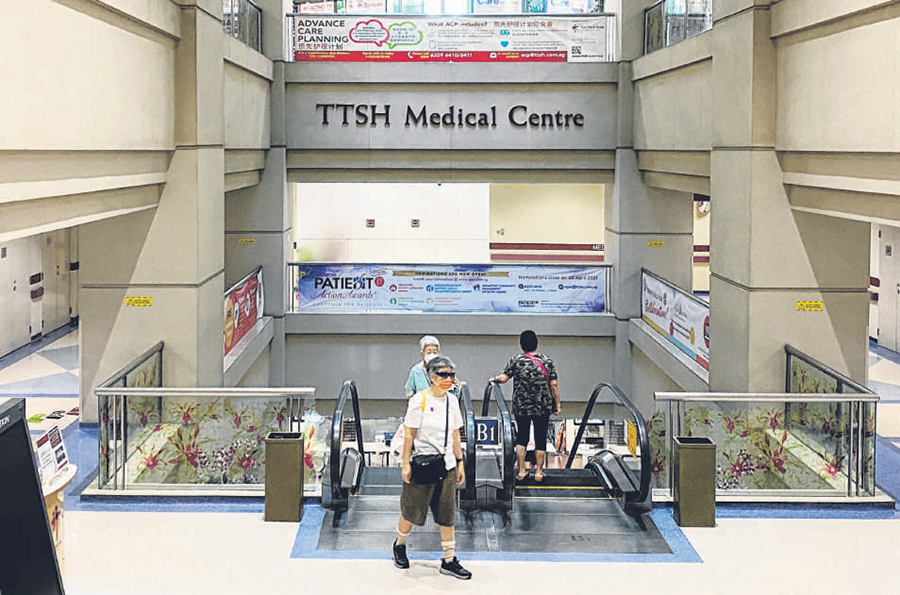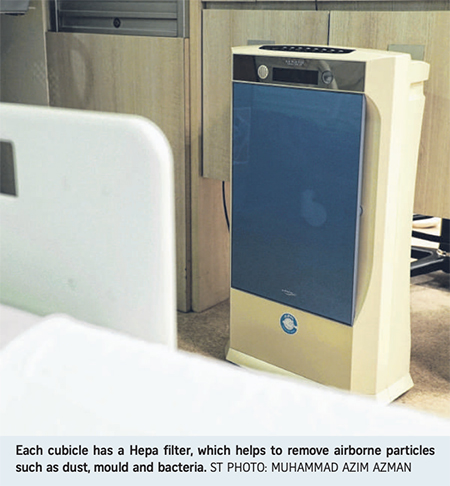Tan Tock Seng Hospital (TTSH) is today reopening Ward 9D – the epicentre of its Covid-19 outbreak – with a suite of enhanced measures to better protect its patients and staff.
Another locked-down ward, 9C, will also be open for admissions from today. Wards 7D and 10B have already reopened for admissions.
Investigations into the cause of Covid-19 transmission within the hospital are ongoing, TTSH said.
Singapore’s director of medical services Kenneth Mak had said on Tuesday that the authorities are investigating the possibility of airborne transmission within the hospital, pointing to reports that suggest a stronger possibility of airborne transmission in certain settings, particularly closed environments with limited airflow and poor ventilation.
To allow for better ventilation and air purification, TTSH has installed exhaust fans and portable high-efficiency particulate air (Hepa) filters in Ward 9D, a C-class ward.
These will be installed in all TTSH wards by tomorrow.
 Ward 9D, which was the epicentre of Tan Tock Seng Hospital’s Covid-19 outbreak, is reopening today. For better ventilation and air purification, the hospital has installed exhaust fans (one can be seen set into a window panel in the background) and portable high-efficiency particulate air (Hepa) filters in the C-class ward.
Ward 9D, which was the epicentre of Tan Tock Seng Hospital’s Covid-19 outbreak, is reopening today. For better ventilation and air purification, the hospital has installed exhaust fans (one can be seen set into a window panel in the background) and portable high-efficiency particulate air (Hepa) filters in the C-class ward.
The hospital halted admissions for two weeks amid a cluster that grew to 46 patients. The cluster was linked to Ward 9D, where a nurse tested positive for Covid-19 on April 27.
Two patients, both linked to the TTSH cluster, have died because of Covid-19 complications.
They are an 88-year-old Singaporean woman who had a history of cancer, high blood pressure, heart failure, stroke and high cholesterol, and a 70-year-old man who had a history of lung cancer and abnormal heart rhythm.
To ring-fence the cases and prevent further transmission, Ward 9D was locked down, with all patients and staff transferred to the National Centre for Infectious Diseases for isolation.
Wards 7D, 9C and 10B were also locked down as there had been exposure to Covid-19 cases within these wards.
Ward 9D, which has a bed capacity of 40, is segregated into cubicles, with an average of six beds per cubicle.
 The hospital is progressively resuming admissions, after conducting six rounds of Covid-19 testing for all inpatients and two rounds for all 12,000 staff on campus. The results have consistently returned negative. ST PHOTO: JASON QUAH
The hospital is progressively resuming admissions, after conducting six rounds of Covid-19 testing for all inpatients and two rounds for all 12,000 staff on campus. The results have consistently returned negative. ST PHOTO: JASON QUAH
Speaking to the media at a visit to the ward yesterday, Dr Hoi Shu Yin, who is chief nurse at Tan Tock Seng Hospital, said that each cubicle within the ward is equipped with exhaust fans to facilitate air change six to 12 times an hour. This way, air in the cubicle is constantly replaced.
In addition, each cubicle has a portable Hepa filter, which helps to remove airborne particles such as dust, pollen, mould and bacteria.
Prior to reopening each ward for hospital admissions, Dr Hoi said, it undergoes one round of deep cleaning, using ultraviolet light and hydrogen peroxide vapour across the entire ward.
The frequency of cleaning for all inpatient wards will be increased from once a day to twice daily, she said.
TTSH on Tuesday had announced that it will be progressively resuming admissions, after conducting six rounds of testing for all inpatients and two rounds for all 12,000 staff on campus. Their swab test results have consistently returned negative.
As part of added precautions, said Associate Professor Bernard Thong, divisional chairman for medicine at TTSH, rostered routine testing will be in place for all staff of the hospital – once every two weeks for those who have been vaccinated, and once a week for those who have not.
More than 80 per cent of the hospital’s staff have been vaccinated so far, he said.
Since the emergence of the cluster, the hospital has also enhanced its use of personal protective equipment (PPE).
MORE PRECAUTIONS
In the inpatient setting, PPE includes the use of goggles, N95 masks as well as gowns... on top of the usual hand hygiene measures and safety measures which have been enforced during this period of time.
- ASSOCIATE PROFESSOR BERNARD THONG, divisional chairman for medicine at Tan Tock Seng Hospital, on the hospital enhancing its use of personal protective equipment (PPE) as part of added precautions.
More than 80 per cent of the hospital’s staff have been vaccinated so far, he said.
Since the emergence of the cluster, the hospital has also enhanced its use of personal protective equipment (PPE).
“In the inpatient setting, PPE includes the use of goggles, N95 masks as well as gowns... on top of the usual hand hygiene measures and safety measures which have been enforced during this period of time,” said Dr Thong.
He also said that staff have been segregated into zones to prevent intermingling.
This proved “very challenging” over the past two to three weeks, he said, as the teams were leaner since a significant number of staff had been placed on quarantine.
Having also been at TTSH during the severe acute respiratory syndrome (Sars) pandemic in 2003, Dr Thong said that the key difference between that outbreak and Covid-19 is that communication – especially through electronic means – has improved significantly.
“We also have very good support staff. In fact, since last year, when we had the outbreak, we looked at the psychological safety of the staff... (to understand) both their personal safety concerns (and) the concerns of their family members and potentially bringing home the infection to their family,” he said.
Thus, the safety measures put in place are “multi-pronged”, as they ensure that the physical and psychological safety of all staff is taken into account, he added.
Better protection for patients and staff
 As part of a suite of measures to better protect its patients and staff, Tan Tock Seng Hospital has installed exhaust fans and Hepa filters, and disinfected its wards with ultraviolet light and hydrogen peroxide vapour before reopening them.
As part of a suite of measures to better protect its patients and staff, Tan Tock Seng Hospital has installed exhaust fans and Hepa filters, and disinfected its wards with ultraviolet light and hydrogen peroxide vapour before reopening them.
The measures are: 99.97 per cent of airborne particles with a size of 0.3 microns. These include dust, pollen, mould and bacteria particles.
Installing these filters in the ward can help to purify the air in the area.
EXHAUST FANS
These fans suck out hot or humid air from a room and expel it outside. Clean air enters through a doorway or vent.
When used in the wards, these fans can help to ensure better ventilation and facilitate air change around six to 12 times per hour.
HEPA FILTERS
Hepa filters, also known as high-efficiency particulate air filters, can remove at least 99.97 per cent of airborne particles with a size of 0.3 microns. These include dust, pollen, mould and bacteria particles.
Installing these filters in the ward can help to purify the air in the area.
ULTRAVIOLET LIGHT AND HYDROGEN PEROXIDE VAPOUR
Both are commonly used for disinfection.
Ultraviolet light, typically in the UV-C range, is widely used for disinfection and sterilising equipment. UV-C radiation can kill the Sars-CoV-2 virus.
According to the United States’ Centres for Disease Control and Prevention, hydrogen peroxide can be used to kill viruses as well as bacteria, yeasts and fungi.